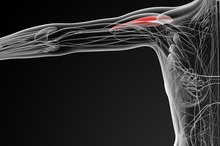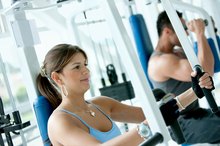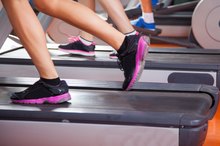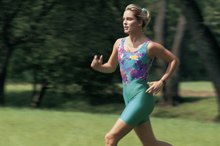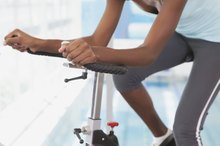VMO Strengthening Exercises
The vastus medialis oblique muscle, more commonly called the VMO, sits above your knee on the inner front part of your thigh. While usually associated with assisting in leg extension, the results of a 2007 study published in "Medicine and Science in Sports and Exercise" indicate that the VMO also plays a key role in knee tracking and knee stability.
Importance
The VMO is often the weakest muscle in the quadriceps group, says sports medicine specialists at the Poliquin Performance Center in Chicago. It is usually the first part of the muscle to atrophy, and the last to rehabilitate. The VMO is most active during the last 10 to 15 degrees of leg extension. Injuries such as anterior cruciate ligament tears, patella dislocation and meniscal tears may impede VMO function, and cause chronic knee pain.
- The VMO is often the weakest muscle in the quadriceps group, says sports medicine specialists at the Poliquin Performance Center in Chicago.
- Injuries such as anterior cruciate ligament tears, patella dislocation and meniscal tears may impede VMO function, and cause chronic knee pain.
Basic VMO Exercise
Stretching Exercises for ACL Injuries
Learn More
Before performing advanced VMO exercises, specialists on the Sports Injury Clinic website suggest checking to see if the muscle group is functioning properly. Sit with your legs extended in front of you, with a towel placed under the back of one knee. Start with the knee slightly bent. Place your fingers on your VMO, and press down against the towel to extend your leg. If the muscle is activating correctly, you will feel it contract under your fingers. If you don't feel the VMO contract, it may not be strong enough for weight-bearing exercise. This sometimes happens after anterior cruciate ligament surgery. Continue practicing the towel pressing exercise until the muscle gains strength. Perform 20 repetitions every day.
- Before performing advanced VMO exercises, specialists on the Sports Injury Clinic website suggest checking to see if the muscle group is functioning properly.
- Place your fingers on your VMO, and press down against the towel to extend your leg.
Non-weight-bearing Exercise
If your doctor or physical therapist advises against weight-bearing exercise, assume a supine position with one knee bent, and the foot placed fat on the floor. Extend the leg toward the ceiling, and wrap a resistance band around your foot. Hold the ends of the band with both hands, and press both of your elbows firmly into the floor. Slowly bend your knee to a 20-degree angle, and then extend your leg against the band's resistance. Add challenge by using a heavier resistance band. Perform 15 repetitions on each leg.
- If your doctor or physical therapist advises against weight-bearing exercise, assume a supine position with one knee bent, and the foot placed fat on the floor.
- Extend the leg toward the ceiling, and wrap a resistance band around your foot.
Sled Drag
Exercising with a Deltoid Strain
Learn More
The Poliquin Performance Center uses an unusual exercise called the Petersen sled drag for vastus medialis oblique rehabilitation and knee injury prevention. The sled consists of a metal platform, with a bar in the middle for attaching barbell plates, and a chain or heavy rope to pull the sled. After placing the weight plates on the sled, hold the rope or chain with your arms relaxed and extended. Keep your legs close together, with your feet slightly turned out. Drag the sled as you take small steps and walk backward for about 25 feet. Lift your heels from the floor as you walk. Perform four sets.
- The Poliquin Performance Center uses an unusual exercise called the Petersen sled drag for vastus medialis oblique rehabilitation and knee injury prevention.
- After placing the weight plates on the sled, hold the rope or chain with your arms relaxed and extended.
Related Articles
References
- PubMed; "Medicine and Science in Sports and Exercise"; New Insights into the Vae Function of the Vastus Medialis with Clinical Implications; H Toumi; July 2007
- Sports Injury Clinic; Vastus Medialis Oblique - VMO
- Poliquin Performance Center; Quadriceps: Training the VMO; July 01, 2004
- Lespasio MJ, Piuzzi NS, Husni ME, Muschler GF, Guarino A, Mont MA. Knee Osteoarthritis: A Primer. Perm J. 2017;21:16-183. doi:10.7812/TPP/16-183
- Kiapour AM, Murray MM. Basic science of anterior cruciate ligament injury and repair. Bone Joint Res. 2014;3(2):20-31. doi:10.1302/2046-3758.32.2000241
- Doral MN, Bilge O, Huri G, Turhan E, Verdonk R. Modern treatment of meniscal tears. EFORT Open Rev. 2018;3(5):260-268. doi:10.1302/2058-5241.3.170067
- Reinking MF. CURRENT CONCEPTS IN THE TREATMENT OF PATELLAR TENDINOPATHY. Int J Sports Phys Ther. 2016;11(6):854-866.
- Petersen W, Rembitzki I, Liebau C. Patellofemoral pain in athletes. Open Access J Sports Med. 2017;8:143-154. doi:10.2147/OAJSM.S133406
- Frush TJ, Noyes FR. Baker's Cyst: Diagnostic and Surgical Considerations. Sports Health. 2015;7(4):359-65. doi:10.1177/1941738113520130
- Huang YC, Yeh WL. Endoscopic treatment of prepatellar bursitis. Int Orthop. 2011;35(3):355-8. doi:10.1007/s00264-010-1033-5
- Beals C, Flanigan D. A Review of Treatments for Iliotibial Band Syndrome in the Athletic Population. J Sports Med (Hindawi Publ Corp). 2013;2013:367169. doi:10.1155/2013/367169
- Tsai CH, Hsu CJ, Hung CH, Hsu HC. Primary traumatic patellar dislocation. J Orthop Surg Res. 2012;7:21. doi:10.1186/1749-799X-7-21
- Ragab G, Elshahaly M, Bardin T. Gout: An old disease in new perspective - A review. J Adv Res. 2017;8(5):495-511. doi:10.1016/j.jare.2017.04.008
- Lee PYF, Nixion A, Chandratreya A, Murray JM. Synovial Plica Syndrome of the Knee: A Commonly Overlooked Cause of Anterior Knee Pain. Surg J (N Y). 2017;3(1):e9-e16. doi:10.1055/s-0037-1598047
- Vaishya R, Azizi AT, Agarwal AK, Vijay V. Apophysitis of the Tibial Tuberosity (Osgood-Schlatter Disease): A Review. Cureus. 2016;8(9):e780. doi:10.7759/cureus.780
- Zanon G, Di vico G, Marullo M. Osteochondritis dissecans of the knee. Joints. 2014;2(1):29-36.
- Hindle P, Davidson E, Biant LC. Septic arthritis of the knee: the use and effect of antibiotics prior to diagnostic aspiration. Ann R Coll Surg Engl. 2012;94(5):351-5. doi:10.1308/003588412X13171221591015
- Gwinner C, Märdian S, Schwabe P, Schaser KD, Krapohl BD, Jung TM. Current concepts review: Fractures of the patella. GMS Interdiscip Plast Reconstr Surg DGPW. 2016;5:Doc01. doi:10.3205/iprs000080
- Voskuil R, Evenski AJ, Montgomery C, Emory CL. Malignant Bone Tumors of the Knee: How to Identify and Treat. J Knee Surg. 2019;32(4):305-314. doi:10.1055/s-0038-1675828
- Gupte C, St mart JP. The acute swollen knee: diagnosis and management. J R Soc Med. 2013;106(7):259-68. doi:10.1177/0141076813482831
- American Academy of Orthopedic Surgeons. Unstable Kneecap.
- Bhatia D, Bejarano T, Novo M. Current interventions in the management of knee osteoarthritis. Journal of Pharmacy & Bioallied Sciences 2013 Jan-Mar;5(1):30-38. doi:%2010.4103/0975-7406.106561
- Bronstein RD, Schaffer JC. Physical Examination of the Knee: Meniscus, Cartilage, and Patellofemoral Conditions. J Am Acad Orthop Surg. 2017 May;25(5):365-374.
- Browne K, Kurtz CA. How to perform a comprehensive examination of the knee. JAAPA. 2009 Jun;22(6):20-25.
- Hergenroeder AC, Harvey BS. (2017). Osteochondritis dissecans (OCD): Clinical manifestations and diagnosis. Bachur RG, ed. UpToDate. Waltham, MA: UpToDate Inc.
Writer Bio
In 1999, Lisa Mercer’s fitness, travel and skiing expertise inspired a writing career. Her books include "Open Your Heart with Winter Fitness" and "101 Women's Fitness Tips." Her articles have appeared in "Aspen Magazine," "HerSports," "32 Degrees," "Pregnancy Magazine" and "Wired." Mercer has a Bachelor of Arts in psychology from the City College of New York.

